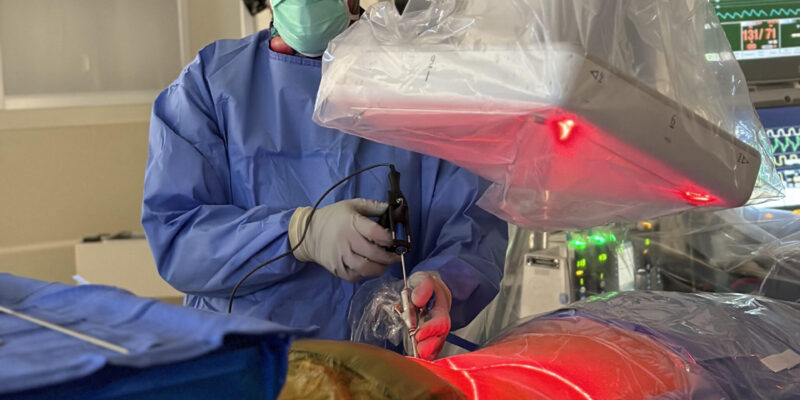Back pain is a widespread ailment affecting millions worldwide, significantly impacting quality of life. While conservative treatments like physical therapy and medication often provide relief, some conditions require surgical intervention. Traditional open spine surgery, while effective, can involve large incisions, extensive muscle dissection, and prolonged recovery periods. Endoscopic spine surgery offers a compelling alternative, providing a minimally invasive approach to address various spinal issues.
What is Endoscopic Spine Surgery?
Endoscopic spine surgery (ESS) utilizes a small incision (typically less than one inch) through which an endoscope, a thin tube equipped with a camera and light source, is inserted. This allows the surgeon to visualize the affected area of the spine on a monitor, guiding the procedure with precision. Specialized instruments are then introduced through the same incision, or through a separate, equally small incision, to address the underlying problem.
Advantages of Endoscopic Spine Surgery:
- Minimally Invasive: The small incision results in minimal tissue damage, reducing pain and scarring compared to open surgery.
- Reduced Muscle Dissection: ESS avoids extensive muscle cutting, which can lead to post-operative pain, weakness, and longer recovery times.
- Faster Recovery: Patients typically experience a faster recovery period and can return to their normal activities sooner compared to open surgery.
- Less Blood Loss: The minimally invasive nature of the procedure significantly reduces blood loss during surgery.
- Lower Risk of Infection: Smaller incisions translate to a lower risk of infection.
- Outpatient Potential: In some cases, ESS can be performed on an outpatient basis, allowing patients to return home the same day.
- Targeted Approach: ESS allows for precise targeting of the affected area, minimizing disruption to surrounding healthy tissues.
Conditions Treated with Endoscopic Spine Surgery:
Endoscopic spine surgery can be used to treat a variety of spinal conditions, including:
- Herniated Discs: ESS can effectively remove the portion of the disc that is pressing on a nerve root, alleviating pain and numbness.
- Spinal Stenosis: In cases of spinal stenosis (narrowing of the spinal canal), ESS can be used to remove bone spurs or thickened ligaments that are compressing the spinal cord or nerve roots.
- Sciatica: ESS can address the underlying cause of sciatica, such as a herniated disc or spinal stenosis, relieving the characteristic pain that radiates down the leg.
- Foraminal Stenosis: This condition involves narrowing of the foramen, the bony openings where nerve roots exit the spinal column. ESS can relieve the pressure on the nerve.
- Facet Joint Pain: ESS can be used to target and treat painful facet joints, the small joints located between the vertebrae.
The Endoscopic Spine Surgery Procedure:
Before the procedure, patients undergo a thorough evaluation, including imaging studies (MRI or CT scan) to determine the source of their pain and assess their suitability for ESS. The surgery is typically performed under local anesthesia with sedation or general anesthesia.
The surgeon makes a small incision, usually on the back or side, and inserts the endoscope. Using the camera’s view as a guide, the surgeon carefully navigates to the affected area. Specialized instruments are then used to remove the herniated disc, bone spurs, or other tissue that is causing compression or pain.
After the procedure, the incision is closed with a few stitches or surgical tape. Patients are typically monitored for a short period before being discharged home.
Recovery After Endoscopic Spine Surgery:
Recovery after ESS is generally faster and less painful than after traditional open surgery. Patients are encouraged to begin walking and light activities soon after surgery. Physical therapy may be recommended to strengthen muscles and improve flexibility. Most patients can return to their normal activities within a few weeks.
Is Endoscopic Spine Surgery Right for You?
Endoscopic spine surgery is not suitable for all patients. The best candidates are those with specific spinal conditions that can be effectively addressed through a minimally invasive approach. A thorough evaluation by a qualified spine surgeon is essential to determine if ESS is the right treatment option.
Conclusion:
Endoscopic spine surgery offers a promising alternative to traditional open surgery for a variety of spinal conditions. Its minimally invasive nature leads to reduced pain, faster recovery, and a lower risk of complications. If you are experiencing back pain and are considering surgery, discuss the possibility of endoscopic spine surgery with your doctor to determine if it is the right choice for you. By understanding the benefits and limitations of this innovative technique, you can make an informed decision about your spinal health and embark on the path to lasting pain relief.
